NatTable 1.1.0 - New & Noteworthy
There are several changes in the infrastructure, the API and the feature set of Nebula NatTable with the 1.1.0 release. Here are the most important ones.
Almost every change in code is tracked via ticket in Bugzilla, so if you are curious about the details and all the bugs that are fixed and enhancements that were added with the 1.1.0 release, have a look here.
Enhancements and new features
There are several enhancements and new features that were added to Nebula NatTable.- Contribution - Active cell editor reference moved to NatTable instance
With this contribution by Michael Heiß the ActiveCellEditorRegistry is deprecated. The active cell editor reference is now stored as member of the NatTable instance to which the current active cell editor belongs to. This solves the issue of having a NatTable as editor control of a NatTable editor.
If you are not using the ActiveCellEditorRegistry in code outside the NatTable, you shouldn't notice this change directly.
The current active cell editor can be requested by callingNatTable#getActiveCellEditor()You can also directly try to commit and close a current active cell editor by callingNatTable#commitAndCloseActiveCellEditor() - Contribution - Enhanced Search Dialog
With this contribution by Tom Hochstein, the search dialog that is shipped with NatTable to support searching within a table, is enhanced to look like the default search dialog in Eclipse. If a SelectionLayer is involved in your layer stack, you can open the search dialog via key combination CTRL+F
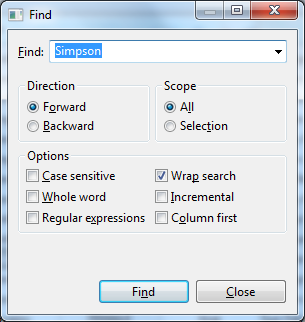
- Contribution - GroupBy summary values
With this contribution by Alexandre Pauzies it is now possible to add summary values for grouped items when the GroupBy feature is used in a NatTable grid.
Similar to the summary row feature, the values are calculated by registering an instance of the new introduced IGroupBySummaryProvider (e.g. SummationGroupBySummaryProvider) for the config attribute GroupByConfigAttributes#GROUP_BY_SUMMARY_PROVIDER.
configRegistry.registerConfigAttribute( GroupByConfigAttributes.GROUP_BY_SUMMARY_PROVIDER, new SummationGroupBySummaryProviderTo be able to register different styles for the summary values, two new labels will be added to the label stack of the cell in case a IGroupBySummaryProvider is registered:(columnPropertyAccessor), DisplayMode.NORMAL, GroupByDataLayer.GROUP_BY_COLUMN_PREFIX + 3); - GroupByDataLayer#GROUP_BY_SUMMARY
- GroupByDataLayer#GROUP_BY_SUMMARY_COLUMN_PREFIX + COLUMN_INDEX
Additionally you are able to show the number of children in a group by configuring a pattern for the config attribute GroupByConfigAttributes#GROUP_BY_CHILD_COUNT_PATTERN. The specified pattern will be added to the groupBy value, where the placeholder {0} will be replaced with the number of children in the list, while the placeholder {1} will be replaced with the number of direct children (without sub-children).
configRegistry.registerConfigAttribute( GroupByConfigAttributes.GROUP_BY_CHILD_COUNT_PATTERN, "[{0}] - ({1})");
Note: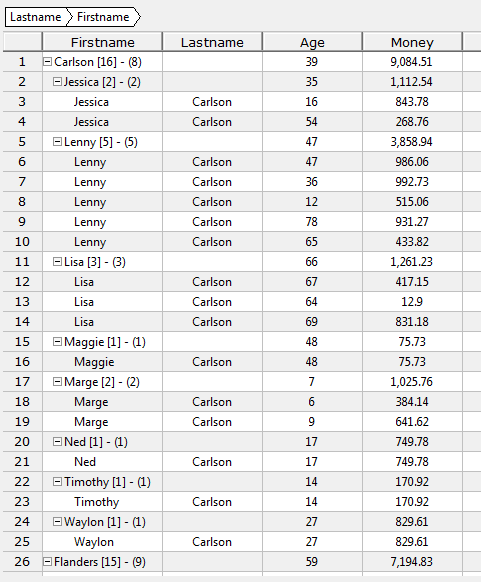
To enable this new feature you need to use the GroupByDataLayer constructor that takes a IConfigRegistry parameter. This is necessary to enable the GroupByDataLayer to access the configured IGroupBySummaryProvider - Added GroupBy area configuration
Added configuration attributes to be able to configure the GroupBy area.
- GroupByConfigAttributes#GROUP_BY_HINT
The text that should be rendered in the GroupBy area in case no grouping is applied. - GroupByConfigAttributes#GROUP_BY_HINT_STYLE
The style that should be used to render the hint in the GroupBy area. - GroupByConfigAttributes#GROUP_BY_HEADER_BACKGROUND_COLOR
The background color that should be used in the GroupBy area.
configRegistry.registerConfigAttribute( GroupByConfigAttributes.GROUP_BY_HINT, "Drag columns here"); Style hintStyle = new Style(); hintStyle.setAttributeValue( CellStyleAttributes.FONT, GUIHelper.getFont(new FontData("Arial", 10, SWT.ITALIC))); configRegistry.registerConfigAttribute( GroupByConfigAttributes.GROUP_BY_HINT_STYLE, hintStyle);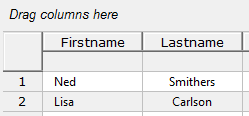
- GroupByConfigAttributes#GROUP_BY_HINT
- Added functionality to collapse and expand all nodes in a tree
To execute that functionality the corresponding commands need to be fired through the layer stack://collapse all nodes in a tree natTable.doCommand(new TreeCollapseAllCommand());//expand all nodes in a tree natTable.doCommand(new TreeExpandAllCommand()); - Hover support
Added two new DisplayModes to support hover styling:
- DisplayMode#HOVER
Applied by the HoverLayer when the mouse moves over a cell in NatTable. - DisplayMode#SELECT_HOVER
Applied by the SelectionLayer when the mouse moves over a selected cell in NatTable and the HoverLayer is involved in the layer stack.
Added the HoverLayer which applies the DisplayMode#HOVER when the mouse moves over a cell in NatTable and fires the necessary events to repaint that cell.
IModeEventHandler additionally implements MouseTrackListener so it is possible to register ui bindings on mouseHover, mouseEnter and mouseExit. - DisplayMode#HOVER
- Added theme styling support
Created the abstract ThemeConfiguration that specifies the theme configurations for NatTable core styling. It is technically a AbstractRegistryConfiguration and can be registered like any other configuration. For theme support and enabling changing the theme at runtime, a ThemeConfiguration should be set to a NatTable instance viaNatTable#setTheme(ThemeConfiguration)Note:
Calling setTheme() need to be done AFTER NatTable#configure() is called. Otherwise the theme styling configuration would get overriden by layer configurations.There are three default themes added to NatTable core:
- DefaultNatTableThemeConfiguration
This is the classic NatTable styling that is used by default for a long time.
- DefaultNatTableThemeConfiguration
- ModernNatTableThemeConfiguration
A more modern looking NatTable.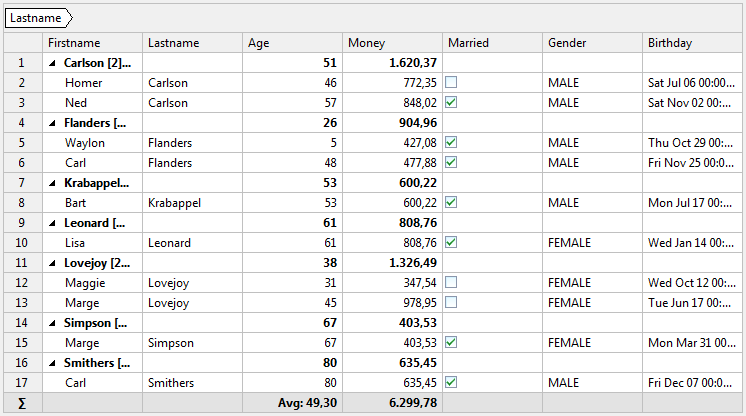
- DarkNatTableThemeConfiguration
A dark NatTable theme that extends the ModernNatTableThemeConfiguration.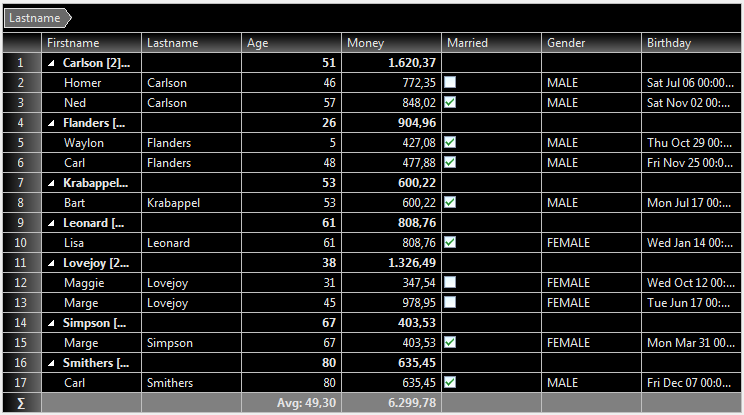
To create a custom theme you can directly extend the abstract ThemeConfiguration or extend one of the default theme configurations.
You can add additional style information to a ThemeConfiguration via IThemeExtensions. This is useful for example to add conditional styling independent of a theme.
As this is a advanced feature, please see the various new examples that were added to the NatTable examples application for further details.

The VerticalTextPainter is rewritten to use SWT.Transform instead of rotating a temporary created image. This is to avoid shading effects on rendering.
In case you are facing any issues you can still use the old implementation which is now accessible via VerticalTextImagePainter.Instead of the hard dependency to model objects, the painters (e.g. ColumnGroupHeaderTextPainter, TreeImagePainter) inspect the label stack. This was necessary to support theme styling without model references.
Created ExportConfigAttributes that contain export related config attributes and removed the old config attributes:
- ExportConfigAttributes#EXPORTER
Configure the ILayerExporter that should be used to perform the export.
moved from ILayerExporter - ExportConfigAttributes#EXPORT_FORMATTER
Configure the export formatter to use.
moved from CellConfigAttributes - ExportConfigAttributes#DATE_FORMAT
New configuration attribute that allows specifying the date format that should be used on exporting.
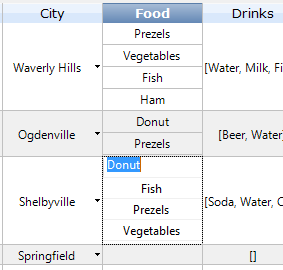
- CellConfigAttributes#GRID_LINE_COLOR
The color that should be used to render the grid lines. - CellConfigAttributes#RENDER_GRID_LINES
Flag to configure whether grid lines should be rendered or not. For example necessary to avoid rendering of grid lines when the BeveledBorderDecorator is used in the header (or render the grid lines for themes that doesn't use beveled borders)
The NatTableBorderOverlayPainter also respects the newly introduced grid line color configuration that is set to the ConfigRegistry.

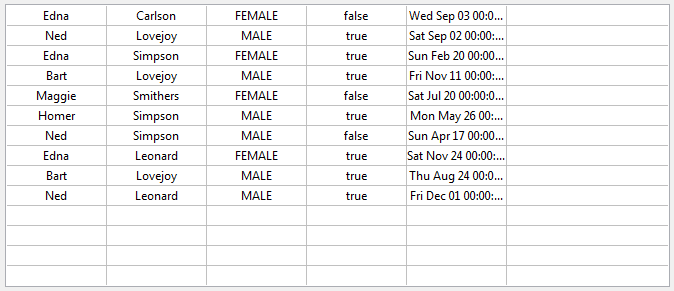
The NumericDisplayConverter is now using NumberFormat for conversion instead of calling toString(). You can also access and modify the set NumberFormat via
- Tutorial Examples
Examples that will be used in future tutorials and are mostly focused on one NatTable feature item. - Classic Examples
Examples that are well known to NatTable users as they exist for a long time.

If starting the new NatTable examples application out of Eclipse fails, delete the file examples.index in the src root folder so it gets re-created. This is necessary because the examples structure has changed!
